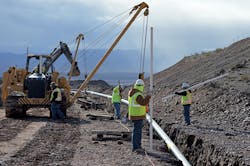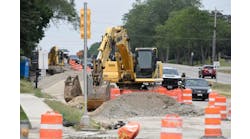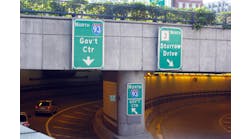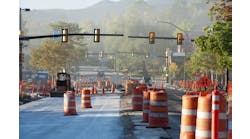A long-awaited stretch of new interstate is finally taking shape in southern Nevada, after years of heated debate, planning and controversy.
The future I-11 will eventually connect Las Vegas and Phoenix, the country’s two largest metropolitan communities currently not linked by an interstate highway. It also marks the first new infrastructure to the 47,856-mile interstate highway system since being deemed complete in 1992.
The Nevada Department of Transportation (NDOT), along with the Regional Transportation Commission of Southern Nevada (RTC), broke ground on the $318 million, 15-mile first segment of I-11 in April 2015. The four-lane freeway will travel from the southern edge of Henderson to the Mike O’Callaghan-Pat Tillman Memorial Bridge, downstream from the Hoover Dam, bypassing the stop-and-go traffic through downtown Boulder City, a small bedroom community southeast of Las Vegas. It marks a critical first step towards fast-tracking the 300-mile trip to Phoenix. The epic-sized project has over 3,000 pages of engineering and architectural design drawings.
Indeed, the first phase of I-11 will improve motorist safety and convenience, while reducing travel time by at least 30 minutes with a direct link that has higher travel speeds and no signal lights. The current stretch of U.S. Hwy. 93 averages 34,000 vehicles daily with heavy truck traffic; however, it is expected to see future growth as part of the CANAMEX Corridor and the North American Free Trade Agreement (NAFTA). Interstate 11 will play an integral role serving the mountain west region, which is expected to add 32 million more residents between now and 2030.
Yet, the project nearly didn’t happen. University of Nevada-Las Vegas researchers discovered naturally occurring asbestos across the jobsite, publishing their findings in late 2013, and subsequently sparking public health concerns that threatened to derail the nearly decade-in-the-making project.
“We hit the brakes until we could learn more about naturally occurring asbestos,” said NDOT Deputy Director Tracy Larkin-Thomason. “It was all new to us and the state. If we couldn’t proceed, and do so safely, then the project risked being scuttled.”
New utility pipework on the I-11 job goes in ahead of paving work.
A proactive pause
The department consequently took nearly a year to learn more about naturally occurring asbestos, researching the material, performing site testing and undertaking fact-finding missions, including trips to Environmental Protection Agency (EPA) Superfund sites like Libby, Mont. There were thousands of soil and air samples tested, and none exceeded federal safety standards for asbestos exposure, said Gary Pons, a certified industrial hygienist with SCS Engineers. NDOT consequently moved ahead with the project, turning to neighboring California—where 44 of 58 counties have naturally occurring asbestos—as a model for developing the state’s first-ever regulatory framework.
Although the I-11 jobsite has only small quantities of natural asbestos, the project still adopted rigorous but necessary testing, education and mitigation measures to ensure public safety. Contractors are consequently undertaking ambient air monitoring at a dozen locations along the project alignment as well as conducting rock and soil testing and soaking the work zone with 1 million gal of non-potable water daily to prevent airborne dust. Additionally, equipment and vehicles are sprayed down before exiting the jobsite, and workers must undergo certified asbestos training.
NDOT opted for concrete after a government study showed a 13-28% long-term savings over asphalt and an estimated 75% maintenance cost savings for the road life.
Section one
NDOT is building the first $83 million section between Silverline Road and Foothill Drive in Henderson, with Fisher Sand & Gravel as general contractor. The 2.5-mile-long stretch of new interstate entails, among other things, building a full diamond interchange at Railroad Pass with a loop ramp, plus a 600-ft-long two-lane cast-in-place flyover bridge from southbound I-11 to eastbound U.S. Highway 93 toward Boulder City. Other project components include creating a 1.5-mile-long asphalt frontage road linking Henderson with the Railroad Pass interchange as well as replanting 20,000 cacti, placing decorative rock and installing five miles of tortoise fencing.
NDOT awarded the construction contract based on best value using a life-cycle equivalency factor, which, in this instance, resulted in concrete rather than asphalt paving, despite a $3 million price difference. The maintenance cost for maintaining asphalt paving would have been three times the cost over 35 years.
“We opted to use concrete pavement due to its longevity, which federally funded studies show costs 13% to 28% less in the long run than asphalt,” said Mary Martini, NDOT district engineer. “It also reduces rutting and potholes, thereby cutting maintenance expenses by up to 75%.”
Meanwhile, the project’s visual centerpiece is a 1,200-ft-long, 28-ft-tall cast-in-place concrete retaining wall, with extruded Cor-Ten steel figures and objects that illustrate scenes from the Hoover Dam’s construction. It reflects the region’s social, cultural and economic history, said NDOT Senior Project Manager Ryan Wheeler, acting as an iconic graphic gateway to Boulder City. Phase one also reconnects the railroad tracks previously severed by U.S. 93 by building a 360-ft-long concrete bridge that allows the mainline freeway to pass underneath.
A rebar cage for a 110-ft-tall overpass pier goes into the ground.
Moving mountains
The Union Pacific Railroad previously had an at-grade crossing over U.S. 93, traversing the 2,367-ft Railroad Pass connecting Henderson with Boulder City. It was paved over in 1998 due to its sharp 64° angle, high highway speeds and scarce usage. Yet, its historical significance and future potential still merited its preservation. The initial phase consequently restores the rail line link to potentially reach Boulder City again via Railroad Pass. A steel prefabricated pedestrian bridge also is being erected that connects the River Mountains Loop and Henderson trail systems.
The RTC, meanwhile, is building the $235 million, 12.5-mile-long access-controlled second freeway section from Railroad Pass to the O’Callaghan-Tillman Memorial Bridge. Las Vegas Paving is the design-build general contractor, with CA Group as lead engineer. However, the RTC needed to negotiate with the Western Area Power Administration and the Colorado River Commission to relocate electrical transmission facilities along the freeway alignment route. They were eventually moved in 2015, clearing the path for construction.
Work entails placing 350,000 tons of asphalt and moving 6.5 million cu yd of earth, including tricky drill and blasting excavation through an El Dorado Mountains ridge done in 30-ft increments, creating benches and shelves, with the explosives placed so that there will be “no teeth marks in the rock,” said Las Vegas Paving Project Engineer Steven Ireland. There were eight rock cuts, with the deepest measuring 1,000 ft across and 250 ft down. Blasting took place almost daily for more than a year and a half, with construction crews working double shifts, night and day to complete the work.
“We are literally moving mountains,” said Las Vegas Paving Project Manager Jared Wagstaff.
The massive undertaking requires a fleet of Caterpillar mining equipment including bulldozers and rock trucks, track excavators and wheel loaders with mechanics and maintenance facilities on-site to keep things continuously running. The largest machines consisted of three Caterpillar 785 rock trucks and a Caterpillar 993 loader. Construction work on both segments is occurring simultaneously.
“I-11 is critical to the continued economic vitality of Nevada,” said Nevada Gov. Brian Sandoval, who chairs the State Transportation Board. “By improving traffic flow between Las Vegas and Phoenix and providing relief to congested north-south highways like I-5 and I-15, the new I-11 will spur increased trade and commerce, advancing our economic development initiatives and ensuring we remain globally competitive.”
The I-11 construction project has been a boon to the region, creating some 4,000 jobs.
Progressing nicely
Indeed, the second phase will feature a northbound truck climbing lane, a reconfigured interchange at the U.S. 93/S.R. 172 Hoover Dam exit, and a southbound scenic vista parking area with a cantilevered metal shade canopy and informational kiosks overlooking Lake Mead. There also will be 10 freeway bridge structures, including “four massive steel girder structures that span canyons that are 100 ft or deeper,” said Wagstaff. Indeed, several bridges span canyons, including a cast-in-place concrete box girder, steel girder, precast arch bridges, and a concrete portal bridge that goes below grade. The largest structure, spanning 280 ft, required a 600-ton mobile crane to set the steel girders into place, while another bridge featured 110-ft-tall pier columns placed inside a steep canyon.
There also are five concrete wildlife crossings up to 60 ft wide for horses and bighorn sheep with 8-ft-tall perimeter fencing to help reduce potentially fatal injuries from vehicle-animal collisions. And there will be two all-terrain vehicle crossings created by installing box culverts under the interstate, said RTC Deputy General Manager of Engineering Fred Ohene. The bridges, scenic overlooks and other project components incorporate Art Deco architectural flourishes, referencing the nearby historic Hoover Dam and its importance to neighboring Boulder City.
Project funding relies on the FHWA’s Advance Construction program, which gives NDOT the option to be reimbursed up to $291 million, or nearly 92% of project-related costs, from its future federal highway funding apportionments. Work also is being funded by $22 million in Fuel Revenue Indexing (FRI) funds from Clark County, along with $5 million in state monies.



